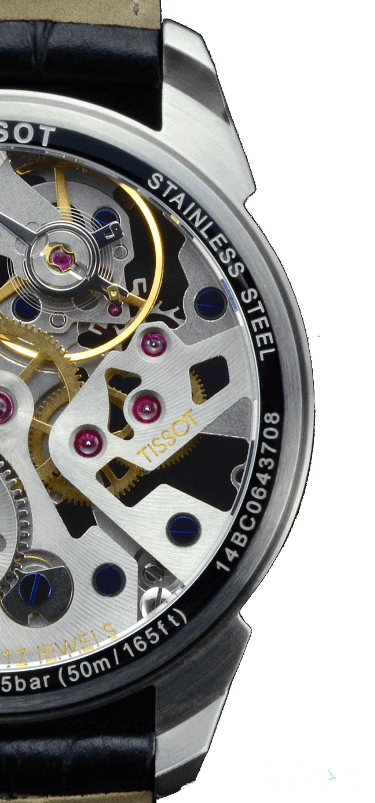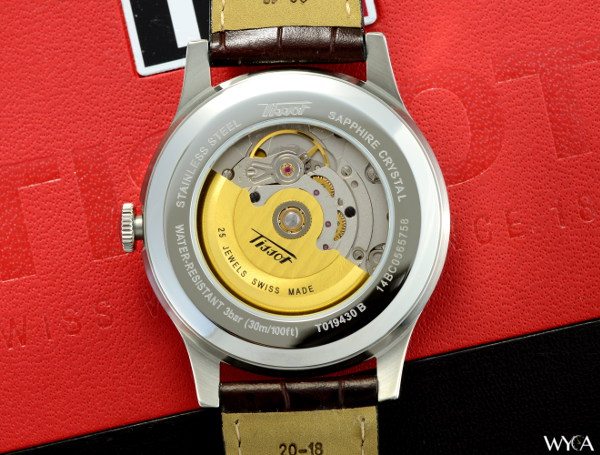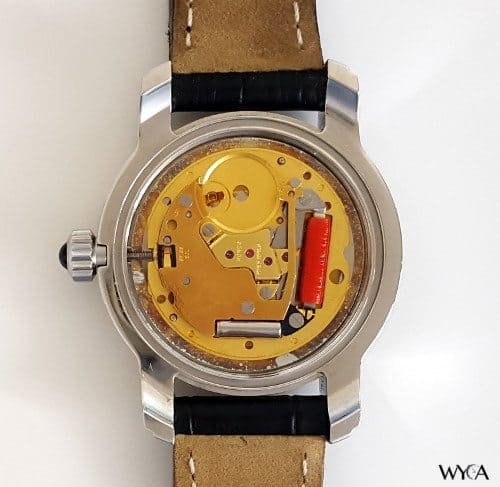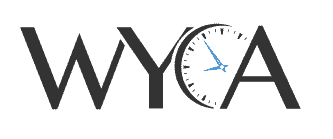 A Movement is to a Watch What an Engine is to a Car
A Movement is to a Watch What an Engine is to a Car
It’s the pivotal component in a watch that generally defines it. Knowing the type of movement in a watch will enable you to make some quick and fairly accurate assumptions: how accurate the watch is, how reliable it will be, and how you will need to maintain it.
Also like an automotive engine, the movement in a timepiece can be decorated and shown off. For those that appreciate the mechanical complexity and engineering prowess that goes into its construction, the movement is as much art as it is function.
Pictured left is the ETA 6497-1 mechanical movement inside the Tissot T-Complication Squelette.
There Are Three Main Types of Watch Movements
- Mechanical – A mechanical movement is wound by hand. As you turn the crown the mainspring is charged.
- Automatic – An evolution of a mechanical movement, an automatic movement uses a swinging pendulum to charge the mainspring.
- Quartz – A quartz movement is battery powered and does not have most of the mechanical pieces needed in a mechanical or automatic movement.
The Movement Controls All Mechanical Functions & Complications
Like an engine, the movement in your watch controls timekeeping and any complications built upon it- there are exceptions to this, but they are uncommon.
Just as how your vehicle’s engine has to power the HVAC and entertainment systems in the car, the movement in your watch needs to power every complication it comes with. This means that if your watch comes with a chronograph and a date function – such as what the H21 automatic movement does inside the Hamilton Jazzmaster Auto Chrono – the movement needs to provide power for all of those functions.
This is what makes the movement inside your watch an engineering accomplishment. The movement in your watch will beat tens of thousands of times per hour – billions of times in-between each servicing – and be accurate to within several seconds per day. With proper care, it will last for decades.
Automatic & Mechanical Movements
 Pictured left: Tissot Visodate Heritage with ETA 2836-2 automatic movement.
Pictured left: Tissot Visodate Heritage with ETA 2836-2 automatic movement.
In most vintage clocks, pocket watches, and wrist watches you will find a mechanical movement. This type of movement is hand wound, relying on the user to manually wind it via the crown.
Automatic movements are another type of mechanical movement. They are versatile and can be used in nearly any application that calls for a mechanical movement.
That isn’t to say you won’t find a mechanical movement inside a modern timepiece. The T-Complication Squelette – pictured at the top of this page – comes with a mechanical movement, as do many other watches from all places in the affordability spectrum.
However, automatic movements are much more widely used due to the convenience and reliability factor. An automatic movement charges via the movement of the wearers arm. As the wearer moves their arm, the rotor swings around a pivot, charging the main spring as it winds the movement. The wearer doesn’t need to remember to wind the movement assuming they wear the watch before its power reserve runs out.
Terms & Phrases
- Mainspring – a spiral spring that contains and releases energy, powering the movement
- Rotor – the part of an automatic movement that swings on a pivot, winding the mainspring
- Power reserve – How long timekeeping can be sustained once fully wound
History & Horology
The mechanical movement is what has powered clocks, pocket watches, and wrist watches for hundreds of years. Horology is both a science and an art, and has developed a rich history as it evolved over time.
Today, horology mainly refers to the creation and study of mechanical timepieces.
Quartz Movements
 Pictured right: Victorinox Vivante with quartz movement (sans battery).
Pictured right: Victorinox Vivante with quartz movement (sans battery).
This type of movement is the most common type of movement powering watches today. Since its invention in the mid-20th century, the popularity of quartz movements has skyrocketed. It’s easy to see why, too: they’re inexpensive to produce, last a long time, accurate, and very reliable.
They also tend to be physically smaller than their mechanical cousins, making them ideal for style-centric designs, thin watches, and any other type of watch where size is a factor.
When first introduced, quartz movements were more expensive than their mechanical counterparts. Of course the opposite is now true today- quartz versions of a watch tend to be considerably less expensive than the mechanical versions.
